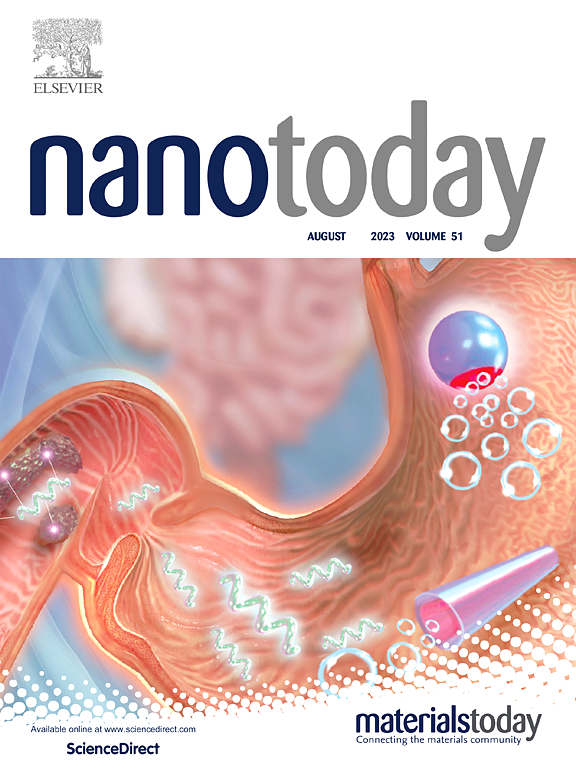Broken but not beaten: Unraveling the biotransformation fate of Mn@PCN224 nanozymes and its influence on enzymatic activity and safety at the human placenta in vitro
IF 10.9
1区 材料科学
Q1 CHEMISTRY, MULTIDISCIPLINARY
引用次数: 0
Abstract
Chronic placental inflammation has been associated with severe pregnancy complications including miscarriage, stillbirth, premature delivery, intra-uterine growth restriction, and recurrence risk in future pregnancies. Treatments are essential, but current standard therapies for infections and inflammation often struggle with limited efficacy and potential side effects. Nanomaterials with enzyme-mimetic properties (nanozymes) have demonstrated impressive medical capabilities especially in inflammation treatment. Remarkably, single-atom nanozymes (SAzymes) including metal-organic frameworks (MOFs) have attracted considerable attention due to their superior substrate affinity and catalytic activity compared to conventional nanozymes. However, due to their high reactivity, nanozymes could undergo biotransformation in biological fluids and tissues, affecting their physicochemical properties and potentially compromising their therapeutic efficacy and safety. On this basis, we performed a systematic study on the chemical and structural biotransformation, catalytic activity and biological impact of a PCN224 MOF at the human placenta in vitro. We engineered a PCN224 MOF, composed of zirconium clusters (Zr6) and 4-carboxyphenyl-porphyrin (H2TCPP), further doping it with Mn (Mn@PCN224) to form Mn-TCPP complexes. These complexes mimic the natural Mn-superoxide dismutase (MnSOD), a crucial enzyme to detoxify cells from radical stress during inflammation. In biological media, Mn@PCN224 underwent rapid and substantial decomposition, leading to a significant release of Mn-TCPP complexes. Nonetheless, despite the observed biotransformation, the SOD activity was maintained, mostly by the free Mn-TCPP bearing the enzyme-like active center. We further revealed that Mn@PCN224 SAzymes and their biotransformation products did not compromise cell viability, barrier integrity and endocrine function in an in vitro human placenta co-culture model. The current findings provide crucial insights about the biotransformation mechanism of a MOF-based SAzyme and emphasize the importance of biostability assessment, in addition to efficacy and safety evaluation.
破碎但未被打败:揭示Mn@PCN224纳米酶的生物转化命运及其对体外人胎盘酶活性和安全性的影响
慢性胎盘炎症与严重的妊娠并发症有关,包括流产、死胎、早产、子宫内生长受限和未来妊娠的复发风险。治疗是必不可少的,但目前治疗感染和炎症的标准疗法往往疗效有限,而且有潜在的副作用。具有模拟酶特性的纳米材料(纳米酶)已经显示出令人印象深刻的医疗能力,特别是在炎症治疗方面。值得一提的是,包括金属有机框架(mof)在内的单原子纳米酶(SAzymes)由于其与传统纳米酶相比具有优越的底物亲和力和催化活性而引起了人们的广泛关注。然而,由于其高反应性,纳米酶可能在生物流体和组织中进行生物转化,影响其物理化学性质,并可能损害其治疗效果和安全性。在此基础上,我们对PCN224 MOF在体外人胎盘中的化学和结构生物转化、催化活性和生物学影响进行了系统研究。我们设计了一种PCN224 MOF,由锆簇(Zr6)和4-羧基苯基卟啉(H2TCPP)组成,并进一步与Mn (Mn@PCN224)掺杂形成Mn- tcpp配合物。这些复合物模拟了天然的锰超氧化物歧化酶(MnSOD),这是一种在炎症期间使细胞从自由基应激中解毒的关键酶。在生物培养基中,Mn@PCN224经历了快速而实质性的分解,导致Mn-TCPP复合物的大量释放。然而,尽管观察到生物转化,SOD活性仍然保持,主要是由带有酶样活性中心的游离Mn-TCPP维持。我们进一步发现Mn@PCN224 SAzymes及其生物转化产物在体外人胎盘共培养模型中不会损害细胞活力、屏障完整性和内分泌功能。目前的研究结果为基于mof的SAzyme的生物转化机制提供了重要的见解,并强调了除疗效和安全性评估外,生物稳定性评估的重要性。
本文章由计算机程序翻译,如有差异,请以英文原文为准。
求助全文
约1分钟内获得全文
求助全文
来源期刊

Nano Today
工程技术-材料科学:综合
CiteScore
21.50
自引率
3.40%
发文量
305
审稿时长
40 days
期刊介绍:
Nano Today is a journal dedicated to publishing influential and innovative work in the field of nanoscience and technology. It covers a wide range of subject areas including biomaterials, materials chemistry, materials science, chemistry, bioengineering, biochemistry, genetics and molecular biology, engineering, and nanotechnology. The journal considers articles that inform readers about the latest research, breakthroughs, and topical issues in these fields. It provides comprehensive coverage through a mixture of peer-reviewed articles, research news, and information on key developments. Nano Today is abstracted and indexed in Science Citation Index, Ei Compendex, Embase, Scopus, and INSPEC.
 求助内容:
求助内容: 应助结果提醒方式:
应助结果提醒方式:


